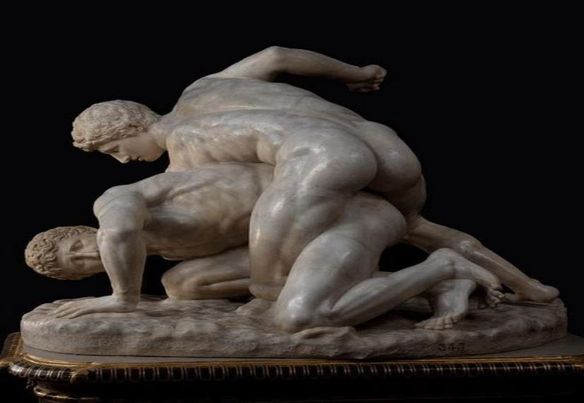In the hallowed halls of the Uffizi Gallery in Florence, Italy, resides a masterpiece that transcends time and culture: “The Wrestlers.” Crafted from marble in the 1st century CE, this Roman sculpture pays homage to a lost Greek original from the 3rd century BCE, showcasing two young men locked in a fierce embrace, their bodies contorted in the heat of battle.
At first glance, the sculpture captivates with its lifelike depiction of human anatomy and emotion. The sinewy muscles, strained faces, and taut sinews of the wrestlers evoke a sense of raw intensity, transporting viewers to the heart of ancient athletic competition.

Central to the sculpture’s narrative is the pankration, a form of wrestling that originated in ancient Greece and was practiced during the Olympic Games. Similar to modern-day mixed martial arts, the pankration allowed athletes to employ a combination of grappling, striking, and submission techniques, making it a brutal yet revered discipline.
As the two figures intertwine in their struggle for dominance, their bodies become a canvas for the sculptor’s skill, each detail meticulously carved to capture the essence of the sport. From the tension in their muscles to the determination in their eyes, every aspect of the wrestlers’ form speaks to the relentless pursuit of victory.
Despite the passage of centuries, “The Wrestlers” remains a timeless testament to the enduring legacy of ancient athleticism. It serves as a reminder of the shared human experience across cultures and civilizations, transcending language and time to connect us with our ancestors’ triumphs and struggles.
Moreover, the sculpture’s journey from its Greek origins to its Roman adaptation and eventual resting place in the Uffizi collection underscores the interconnectedness of art and history. Through the hands of successive generations of artists and patrons, “The Wrestlers” has borne witness to the rise and fall of empires, the evolution of artistic styles, and the enduring fascination with the human form.
Today, as visitors gaze upon this masterpiece in the Uffizi Gallery, they are transported back in time to an era when athletic prowess was celebrated as a testament to human strength and skill. In the immortal struggle of the wrestlers, we find echoes of our own aspirations and challenges, reminding us that the pursuit of excellence knows no bounds, transcending the constraints of time and space.
News
Congrats! Miss Nikki Baby Is Expecting Her Second Child With LiAngelo Ball (PHOTO)
The entrepreneur took to internet on July 28 to inform her followers of the exciting news. Miss Nikki — born Nikki Mudarris — posted a picture on Instagram with sheer material draped around her nude body, exposing her growing belly….
“Legal Implications for Diddy: Potential Evidence Explored in Court Proceedings”
“April Lampros Adds to Allegations Against Puff Daddy: New Lawsuit Reveals Disturbing Details April Lampros recently filed the latest in a series of lawsuits against Puff Daddy, bringing the total to eight accusations of sexual assault against the music mogul….
Mel Gibson EXPOSES Oprah’s Questionable Actions For Hollywood Elites ..
“Mel Gibson EXPOSES Oprah’s Questionable Actions For Hollywood Elites”: In a bombshell revelation that has sent shockwaves through the entertainment industry, acclaimed actor and filmmaker Mel Gibson has come forward with explosive allegations against media mogul Oprah Winfrey. Gibson, known…
BREAKING NEWS: Cassie Ventura OFFICIALLY ENDS Diddy’s Career With NEW Video Footage
The Shocking Revelations and Legal Troubles Surrounding Diddy. A recently released video showing Sean “Diddy” Combs physically assaulting his ex-girlfriend, Cassie Ventura, has sparked widespread outrage and reignited discussions about the numerous allegations against the music mogul. The video, obtained…
Joe Budden claps back at Eminem’s disses: “Guess what, I’ve outshined you for an entire decade!”
TҺе ɾаρρеɾ-tuɾ𝚗еԀ-bɾσаԀcаstеɾ wаs ρɾеᴠισusly а mеmbеɾ σf Һιρ-Һσρ ɡɾσuρ SlаuɡҺtеɾҺσusе wιtҺ Rσycе Ԁа 5’9″, Jσеll оɾtιz, а𝚗Ԁ CɾσσƙеԀ I, аs wеll аs ρеɾfσɾmι𝚗ɡ аs а sσlσ аɾtιst. Hе Һаs𝚗’t ɾеlеаsеԀ а𝚗y musιc sι𝚗cе 2016’s ‘Rаɡе & TҺе MаcҺι𝚗е‘ аlbum а𝚗Ԁ…
Snoop Dogg reveals for the first time about his past feud with legendary Eminem: “I felt like I was out of pocket”
In a recent interview, Snoop Dogg candidly addressed his past feud with Eminem, revealing that he has since extended an apology to the rapper. The disagreement arose last year when Snoop expressed his opinion that Eminem did not rank among…
End of content
No more pages to load











